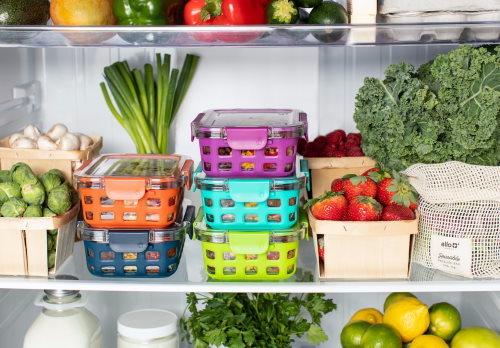In a perfect world, we may see ourselves always knowing exactly what fridge foods we have, what’s for dinner, and even have frozen foods thawed and ready to go. Even better, we have confidence that the food is all prepped and ready to go to make mealtime effortless.
For many of us, unfortunately, that doesn’t even come close to reality. We come home tired and hungry, only to find a fridge full of questionable leftovers, empty shelves, or food that takes longer to prepare than we have energy for—especially on a busy night.
Fortunately, by stocking up on healthy fridge foods, we can make those, er, let’s say rare, “I completely forgot to plan dinner” (or breakfast, lunch, or snacks) days matter a whole lot less.
BREAKING: Viagra Obsolete: New Invention Cheaper, Safer, Faster
In other words, having these essential fridge foods on hand and ready to grab can make it much easier to stay on track with your healthy eating plan.
25 Healthy Fridge Foods
Drinks
1. Selzer water: Let’s face it, sometimes you want something that’s a little more flavorful or fizzy than plain old tap water. Seltzer waters can be consumed as is or brightened with a splash of juice or some sliced fruit for a little extra something, something.
2. Coconut water: While not exactly essential, if you want to give yourself an electrolyte boost after tough workouts, then keeping some coconut water in the fridge is a good way to help you rehydrate.
3. Milk alternative: Plant-based milks are becoming more and more popular. You can choose from almond, hemp, coconut, cashew, oat, rice, and more. While you may not always just drink a glass right out of the fridge, they’re perfect in a latte, smoothie, mixed into your oatmeal, or when making creamy dishes. You can even use these kinds of milk for a sweet treat by mixing any of them with frozen bananas and a drizzle of honey. Yum! (There are also health benefits of cow’s milk, so if that’s what you prefer, don’t let us stop you.)
Snacks
4. Cut up veggies: One of the most convenient snacks is sliced vegetables. Choose a variety of veggies, such as celery, radishes, cucumbers, bell peppers, carrots, broccoli, cauliflower, and more. You can pull them out to snack on or use them as the stars of the show in a super quick stir-fry or steamed or roasted for an easy side dish.
5. Hummus: Made from chickpeas, olive oil, garlic, a splash of lemon, and the rich flavor of tahini, hummus is delicious. Rich in fiber and protein, a couple of tablespoons of hummus are not only the perfect addition to cut-up vegetables, but they can also be used in place of mayo on a sandwich or wrap to make it more filling and nutrient-dense.
6. Plain Greek Yogurt: Rich in protein, low in sugar, and so versatile, Greek yogurt combines well with fruit for a sweet treat, spices for a creamy veggie dip, or with a range of foods that you typically top with sour cream. With plain Greek yogurt on hand, you can almost always whip up something that’s healthy, creamy, and delicious!
7. Fresh Fruit: Loaded with antioxidants, fiber, and vitamins and minerals, fruits are another quick, convenient snack. Berries are both low in calories and high in nutrients. But don’t overlook watermelon, citrus fruits, apples, pears, or stone fruits—especially when they’re in season.
8. Frozen Ripe Bananas: Anytime you notice bananas getting a little more ripe than you like them, peel them and cut them into chunks to store in the freezer. They then become the perfect addition to a dessert-like smoothie or as a delicious alternative to ice cream when blended.
9. Nuts and seeds: While often left in the back of the pantry, nuts and seeds last longer when kept in the fridge. Grab a small handful of pistachios, walnuts, or almonds for a quick snack. Or keep some pumpkin seeds, sunflower seeds, or hemp seeds on hand to sprinkle on top of a salad, soup, or fruit cup. Don’t forget chia seeds and flaxseeds, as they’re both nutrient powerhouses that can be added to overnight oats, smoothies, or on top of yogurt, smoothie bowls, and salads.
10. Hard-boiled eggs: When you want some fast yet portable protein, hard-boiled eggs are hard to beat. Eat them alone or cut them up to add to avocado toast, a salad, or a healthy ramen bowl.
11. Cheese: Yes, you do need to be aware of serving sizes, as calories and sodium can add up quickly, but cheese makes a quick, convenient snack and also adds a delicious punch of flavor to many recipes.
Staples
12. Eggs: Don’t hard-boil all of your eggs, as raw eggs are an inexpensive, high-quality protein that’s highly versatile. Eggs aren’t just for breakfast. Whether you like chips and eggs, a dinner omelet, or quiche, eggs can be the foundation of many filling, delicious meals any time.
13. Bone broth: Because it’s so nutrient-dense and high in collagen, bone broth makes for not only the perfect base for many soups but can be used to flavor other recipes (e.g., noodles, stir-fries, soups, and meats. It can even be a warming beverage, especially when you’re feeling under the weather.
TRENDING: This Keeps Your Blood Sugar Below 100 - Even When You're Eating Sweets!
14. Overnight oats: One of the fastest, easiest, and most filling breakfast options, overnight oats have become super popular for good reason. Make enough for the week when you’re meal prepping, and you’ll never wonder what’s for breakfast again. You may even wake up more easily knowing you have something so tasty waiting for you.
15. Leafy greens: Kale, collard greens, spinach, and even romaine are must-have fridge foods. They’re rich in antioxidants, vitamins, minerals, fiber, and other nutrients. Yet they’re super low in calories, digest easily, and fit into just about any meal plan. So, while they’re great as the base of a salad, you can also throw a handful in your smoothies, steam them up as a side dish, or stir them into soups, spaghetti sauce, eggs, and so much more.
16. Fresh herbs: From parsley to cilantro to thyme, rosemary, sage, and dill can make any dish more flavorful and nutrient-rich. To help your herbs last longer, place them upright in water like little bouquets. It will also make your fridge look pretty and may just give you something to smile about anytime you’re pulling out food to make or eat.
17. Sauerkraut: If you find any recipe lacks flavor, a spoonful of sauerkraut can transform it with its lively taste. What’s more, as long as it’s fermented, it’s loaded with nutrients, including both pre- and probiotics to help keep your gut healthy. If you prefer a little more of a spicy kick in your fermented vegetables, give kimchi a try.
18. Pickles: Fermented cucumbers are another fridge food that provides a powerful punch of flavor. While they are high in sodium, those that are made through fermentation are also a great source of healthy bacteria, similar to sauerkraut.
19. Ricotta Cheese: While cottage cheese may be more familiar (and is another good choice), ricotta is actually higher in protein and calcium. It’s not only good in pasta dishes but it can be used to spread over toast or in wraps or as a creamy, protein-rich base in dips and to place on top of fruits.
20. Peanut (or other Nut) Butter: Nut butters made with just one ingredient (i.e., nuts) are perfect for upping the flavor and nutrient level of everything from rice cakes to smoothies to celery to a good old PB&J or on top of a banana. Tahini, of course, is essential for making hummus. Remember to avoid nut butters loaded with added sugars, salt, oils, and other unnecessary additives. (To help prevent the mess of all-natural nut butters, store them in your pantry lid-side-down. Then, turn upright immediately before use and stir, storing in the fridge once opened.)
21. Tortillas: For a quick wrap, taco, burrito, quesadilla, etc., keep some tortillas on hand. If you won’t be using them within the week, you can easily store them in the freezer, where they can last up to six months.
Condiments
22. Dijon (or brown, whole-grain, or yellow) Mustard: Once you’ve made your own salad dressing, you’ll likely never (or rarely) go back to store-bought—it just tastes so much better, costs less, and leaves out all the unnecessary additives. Dijon mustard is the delicious base for many such mustards and helps the ingredients stick together. Of course, it’s also a good smear on any sandwich or wrap and also is an important ingredient for many recipes from potato salad to Deviled eggs and so much more.
23. Maple syrup: Move over sugar and make way for maple syrup. Sure, it’s still a calorie-heavy sweetener, but maple syrup isn’t just empty calories as it does include nutrients like antioxidants. It can be used to sweeten way more than pancakes and waffles. Add a drizzle over oatmeal or breakfast parfaits and even in homemade salad dressings. Do, however, skip those that are made with artificial sweeteners or corn syrup and choose the real thing. Other potential healthier sweeteners to keep on hand include honey and dates.
24. Coconut Aminos: If you want to add a savory yet salty, umami flavor to noodles, rice, stir-fries, etc., then coconut aminos are an essential condiment that’s used in sauces, marinades, stir-fries, and more. If you don’t have coconut aminos, you can also use soy sauce or tamari instead. Coconut aminos, though, have a similar flavor (though it’s a bit sweeter and more mild), yet it’s lower in sodium as well as soybean- and wheat- (and gluten-) free. Another lesser-known umami option you may want to consider is miso paste, which is a great addition to salad dressings, pasta, and stir-fries.
25. Salsa: This tomato-based essential (at least in our home) is a great source of vitamin C and other antioxidants. It’s also a highly versatile ingredient that can add life to many different recipes from eggs to burritos to avocado toast and so much more.
You may be wondering where the other protein sources are on this fridge foods list—i.e., fish, meat, poultry, or tofu. Yes, these will be stored in the fridge, but they’re also foods that will rapidly move through your refrigerator. Because they can spoil within days, if you aren’t eating them right away, they’re likely still at the store waiting to be purchased or safely stored in the freezer. But if that’s what you’re having for dinner tonight (or tomorrow night), then of course, they’re fridge foods to ensure you have on hand.
BREAKING: Newly Legalized Herb Relieves Pain - Available Without A Prescription
What Fridge Foods Do You Keep on Hand?
Depending on your flavor preferences, diet preference, and how often you cook and eat at home, you’re fridge foods may vary. The above foods, though, can provide an abundance of nutritious meals, even on those nights you didn’t plan as well for dinner or just want to make your next meal easier. Bon appétit!









